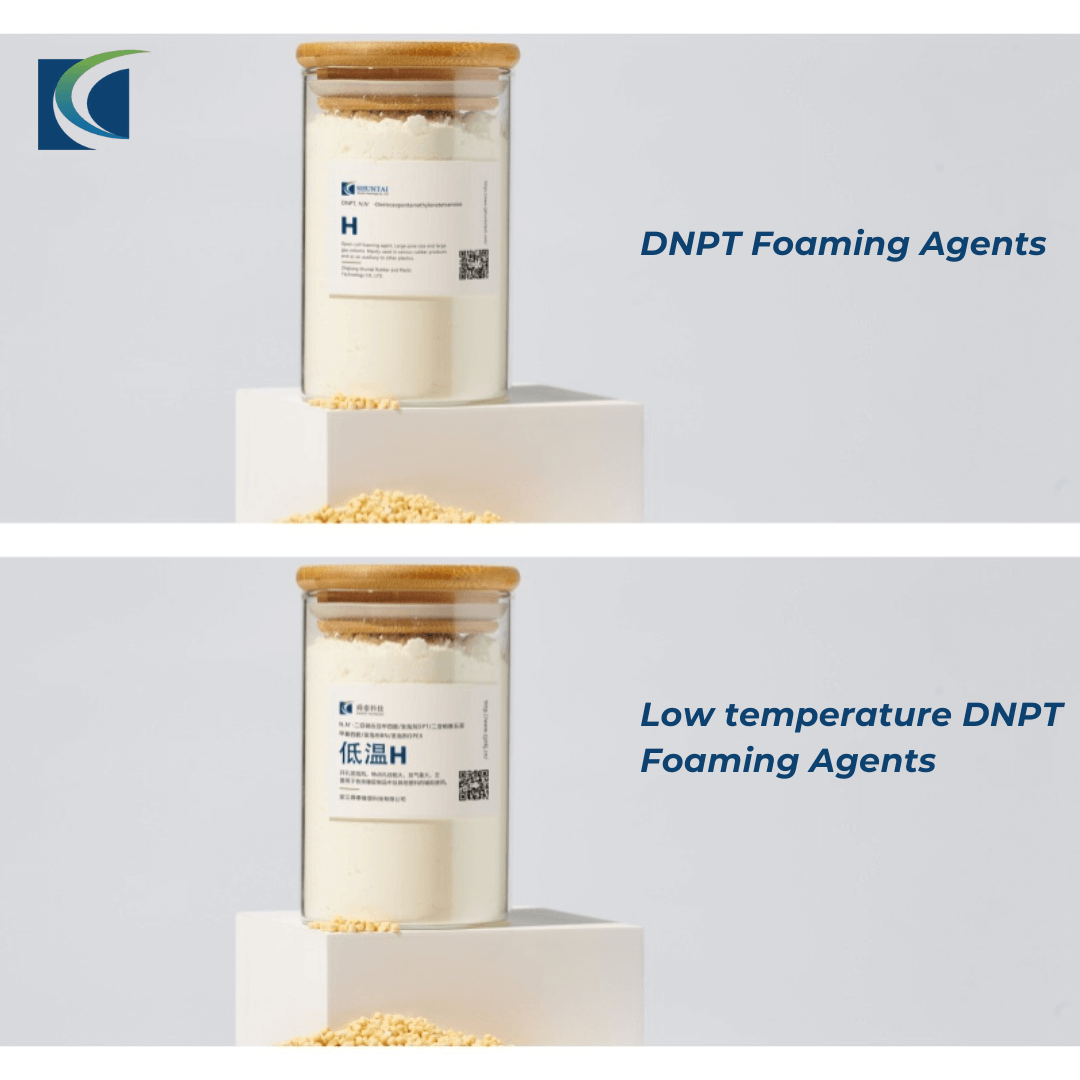DNPT, scientific name Dinitroso pentamethylene tetramine, full name in English is N,N'-Dinitroso pentamethylene tetramine . In terms of chemical structure, its molecule consists of a specific combination of atoms, showing the chemical formula (NO)₂(CH₂)₅N₄ . This special molecular structure determines that it possesses unique chemical activity, which is the key to its ability to act as an efficient foaming agent. At the microscopic level, functional groups such as nitroso (-NO) in its molecule are able to react chemically under specific conditions, thereby releasing gases that provide the necessary conditions for the foaming of the material.

Physical property analysis
Appearance Characteristics: DNPT blowing agent usually appears in the form of light yellow loose crystals or powder. This appearance has a certain significance in the actual production and application, the loose state is conducive to its uniform dispersion in the raw material, laying the foundation for the subsequent foaming reaction. For example, in the rubber mixing process, light yellow powder DNPT can be more easily mixed with the rubber matrix to ensure the consistency of foaming.
Key physical parameters
Melting point: Its melting point is in a specific range, and this parameter influences its stability during processing. In processes that require high temperatures, the melting point determines when the physical state of DNPT begins to change, which in turn affects the onset of the foaming reaction.
Decomposition Temperature: Decomposition temperature is one of the core physical parameters of DNPT blowing agents, and is generally in the range of 190 - 205°C. When this temperature is reached, DNPT will not be able to decompose. When this temperature range is reached, DNPT will decompose and release gases. Different application scenarios require different decomposition temperatures, for example, in some rubber vulcanization processes, the temperature needs to be precisely controlled so that DNPT decomposes at the right stage to obtain the ideal foaming effect.
Density: Density affects the dispersion behavior in different material systems. A suitable density helps DNPT to be evenly distributed in the raw material, avoiding agglomeration, thus ensuring the uniformity of foaming.
Analysis of Chemical Properties
Decomposition reaction mechanism: The decomposition reaction of DNPT is a complex chemical process. After reaching the decomposition temperature, the chemical bonds within the molecules are broken and reorganized, and eventually decompose to produce a gas whose main component is nitrogen. The chemical reaction equation is simple: (NO)₂(CH₂)₅N₄→ N₂↑ + other decomposition products. The release of nitrogen provides a source of gases for the formation of a pore structure within the material, and these gases expand within the material, prompting foaming.
Reactivity with Other Substances: DNPT reacts with other chemicals in some specific environments. For example, it is able to regulate its decomposition temperature when used with certain organic acids (e.g., salicylic acid, adipic acid, etc.) or substances such as urea. This characteristic is very important in actual production, by adding these additives, according to the processing temperature requirements of different materials, the decomposition temperature of DNPT can be flexibly adjusted, so that it can play the role of foaming under the appropriate process conditions. But at the same time, DNPT should avoid contacting with strong acids and alkalis, because it may react violently, affecting its performance and even causing safety problems.
Foaming performance advantages
High gas generation and multiplication: DNPT blowing agent has high gas generation capacity, generally up to 260 - 290mL/g. This means that DNPT can release a large amount of gas when decomposing per unit mass. This means that a large amount of gas can be released when DNPT decomposes per unit mass. The high gas generation enables it to provide a sufficient source of gas for the material during the foaming process, thus realizing a high foaming ratio. In the production of foam rubber, for example, a higher foaming ratio results in a lighter texture and better cushioning properties of the rubber product.
Temperature Controllable and Stable: As mentioned above, by adding specific additives, the decomposition temperature of DNPT can be adjusted within a certain range, from the original 190 - 205℃ to 90 - 190℃. This temperature controllability allows it to be adapted to the processing temperature requirements of different materials. At the same time, the decomposition temperature of DNPT is relatively stable when used alone, which facilitates process control during production. During the plastic foam molding process, a stable decomposition temperature helps to ensure consistent foaming results from batch to batch, improving the stability of product quality.
Fine Bubble Hole Regulation: DNPT is able to effectively regulate the structure of the bubble holes under suitable process conditions. It can make the bubble holes formed inside the material more uniform in size, and the distribution of pore size in a relatively narrow range. The uniform and fine pore structure is of great significance for the improvement of the material's performance. In the foam used in the field of thermal insulation, uniform pores can reduce the channel of heat transfer, improve thermal insulation performance; in rubber products, uniform pores can improve the strength and elasticity of the product.
Wide range of applications in multiple fields
Plastics industry
Polystyrene (PS) foaming: DNPT plays an important role in PS foaming process. It can make the PS material form rich microporous structure, and produce foam polystyrene products with good heat insulation and sound insulation performance. DNPT blowing agent is indispensable for the production of common disposable foam lunch boxes and polystyrene foam panels for construction. By controlling the amount of DNPT and the parameters of the foaming process, the density and cell structure of PS foam can be adjusted to meet the needs of different applications. Polyethylene (PE) and polypropylene (PP) modification: For PE and PP materials, DNPT can be used to prepare foamed products and improve the material properties. Foamed PE and PP materials have a lower density and reduced weight while maintaining a certain level of strength. In the field of packaging, foamed PE and PP materials can be used as cushioning packaging materials to effectively protect products from damage during transportation; in automotive interior parts, foamed PP materials can also be used to reduce the weight of automobiles and provide a certain degree of comfort.
Rubber products
Sponge Rubber Manufacturing: Sponge rubber is characterized by softness, good elasticity and excellent cushioning performance, and DNPT is one of the commonly used foaming agents for manufacturing sponge rubber. DNPT is added in the rubber mixing process, and after vulcanization and other processes, DNPT decomposes and produces gas, so that a sponge-like porous structure is formed inside the rubber. This kind of sponge rubber is widely used in cushions and cushions in daily life, as well as shock-absorbing cushions in the industrial field.
Rubber Seals
DNPT is also used in the production of rubber seals. Through the foaming process, the seals can be made to have better flexibility and fit to improve the sealing effect. For example, in sealing gaskets for automobile engines, foamed rubber seals containing DNPT blowing agent are used to better adapt to the engine's operating environment and prevent liquid and gas leakage.
Building insulation
In the field of building insulation, DNPT blowing agents can be used to prepare insulation materials such as foam concrete. Foam concrete has good thermal insulation, fireproofing and sound insulation properties, and is also lightweight, which can reduce the load on the building.The application of DNPT in foam concrete helps optimize the pore structure of the material, and improve the thermal insulation performance and strength.
Packaging materials
DNPT can also be used to produce some special packaging materials. For example, in the packaging of some electronic products, packaging materials with anti-static and good cushioning properties are required. Foamed materials prepared with DNPT blowing agent can meet these requirements and effectively protect electronic products during transportation and storage.
Points for operation and storage
Strict requirements for storage environment
Temperature and humidity control: DNPT blowing agent should be stored in a cool and dry environment. Excessive temperature may lead to premature decomposition and affect the use effect; excessive humidity may cause DNPT to become damp and agglomerate, which will also affect its performance. It is generally recommended that the storage temperature should be between 5 - 25℃ and the relative humidity should be controlled at 40% - 60%. When storing in the warehouse, temperature and humidity monitoring equipment can be installed to monitor the temperature and humidity changes in the storage environment in real time to ensure compliance with the requirements.
Light avoidance and ventilation:
DNPT is sensitive to light, and prolonged exposure to sunlight may trigger decomposition reactions. Therefore, storage containers should be made of light-avoiding materials, such as brown glass bottles or black plastic buckets. Meanwhile, the storage place should be well ventilated to avoid the accumulation of gases generated by the decomposition of DNPT and reduce the safety risk.
Production and operation safety norms
Anti-static and explosion-proof measures: Since DNPT will produce flammable gas during decomposition and its powder form is prone to generate static electricity, strict anti-static and explosion-proof measures must be taken during production and operation. The production equipment should be well grounded, and the operators should wear anti-static working clothes and shoes to avoid static sparks. At the same time, the production workshop should be set up with explosion-proof electrical equipment, and open flames are strictly prohibited to prevent explosions.
Protective Equipment and Emergency Response: When operators are exposed to DNPT, they must be equipped with appropriate personal protective equipment, such as anti-virus masks, protective gloves and protective clothing. Anti-toxic mask can prevent inhalation of harmful gases generated by the decomposition of DNPT; protective gloves and protective clothing can avoid direct skin contact with DNPT and reduce skin irritation. In addition, the enterprise should make a perfect emergency response plan, so that when an accidental leakage or accident occurs, it can quickly take effective countermeasures to reduce the loss.

